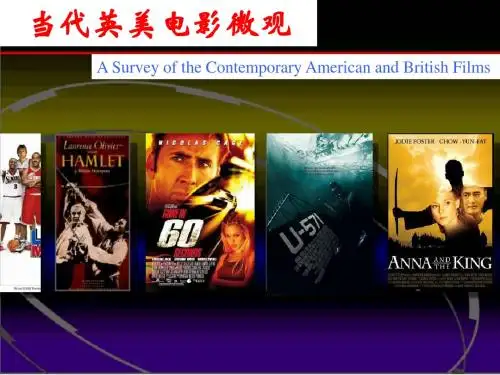电影发展史-发展期(英文版)ppt课件
- 格式:ppt
- 大小:550.50 KB
- 文档页数:11











美国电影发展历程英文The Development of American FilmThe history of American film stretches back over a century, and it has had a significant impact on global cinema. The development of the American film industry can be divided into several key periods, each marked by technological advances, artistic innovation, and changing cultural and social attitudes.The early years of American cinema, from the late 19th century to the early 1900s, were characterized by short, silent films. These films were often shown in nickelodeons, small storefront theaters that could seat hundreds of people. Thomas Edison and the American Mutoscope Company were two key players during this period, producing films such as "The Great Train Robbery" in 1903, which is considered one of the first narrative films.The 1920s saw the rise of Hollywood as the center of the American film industry. With its favorable weather and diverse scenery, Hollywood became an ideal location for film production. Major studios such as Universal and Warner Bros. were established during this time, and the introduction of synchronized sound in films with "The Jazz Singer" in 1927 revolutionized the industry. This period also gave birth to many iconic stars, including Charlie Chaplin and Buster Keaton, who are still recognized today.The 1930s and 1940s, commonly known as the Golden Age of Hollywood, saw the production of multiple classics that are still celebrated today. The introduction of color film and widescreen formats further enhanced the cinematic experience. Some of themost revered films of this era include "Gone with the Wind" (1939) and "Casablanca" (1942). Additionally, Hollywood played an essential role in boosting morale during World War II, producing patriotic films that reflected the nation's spirit.In the 1950s, the rise of television posed a significant challenge to the film industry. To combat declining attendance, Hollywood responded with widescreen formats like Cinemascope and 3D, as well as epic spectacles such as "Ben-Hur" (1959). This period also saw the emergence of new genres, including science fiction and horror, with films like "Invasion of the Body Snatchers" (1956) and "Psycho" (1960).The 1970s witnessed a shift in American filmmaking, with the rise of independent cinema and the New Hollywood movement. Directors such as Martin Scorsese, Steven Spielberg, and Francis Ford Coppola brought a level of artistic and narrative complexity that challenged traditional storytelling conventions. Films such as "Taxi Driver" (1976), "Jaws" (1975), and "The Godfather" (1972) captured the attention of both critics and audiences, earning critical acclaim and box office success.In recent decades, American cinema has continued to evolve and diversify. Hollywood has seen the emergence of blockbuster franchises and superhero films, as well as a growing focus on representation and inclusion, showcasing stories from underrepresented communities. Independent filmmaking has thrived, often pushing boundaries and exploring new narratives.In conclusion, the development of American film is a testament tothe innovative spirit, cultural influence, and global reach of the industry. From the early silent films to the present-day blockbusters, American cinema has continuously evolved, reflecting the changing tastes and values of audiences worldwide.。